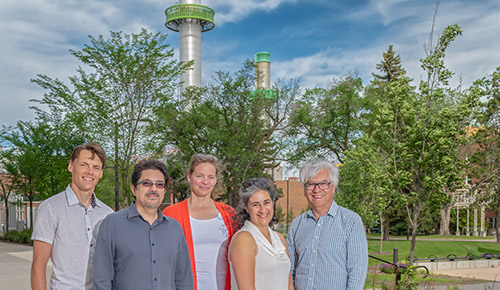
Graduate students use their knowledge and experiences from different disciplines to collaborate with professor Alvaro Osornio-Vargas to study industrial emissions and adverse birth outcomes. Pictured left to right are colin Bellinger, Jesus Serrano, Charlene Neilsen, Osnat Wine and Alvaro Osornio-Vargas.
At the Children's Environmental Health Clinic (ChEHC), patients come in with a wide variety of complaints- from lingering upper-respiratory infections and bowel problems, to developmental problems like ADHD and autism. "It seems to cover the whole of pediatric issues," says Irena Buka, ChEHC's clinical director and a clinical professor in the department.
What all of the cases have in common is a possible link to environmental causes, but no clear treatment plan. Buka explains that, much of the time, patients are experiencing a problem that even the clinic's doctors have never seen before. "We go to the scientific literature to see if anyone has seen it and written about it. Sometimes, it isn't there and we realize this requires completely new research to answer our questions."
A partnership between the Department of Pediatrics, Alberta Health Services, and Covenant Health, ChEHC isn't just a clinic where patients come to see a physician: it is also a place of research and public education about the environment's role in child health. But it is most often the clinic's patients who drive the selection research projects.
The Data Mining and Adverse Birth Outcomes (DoMiNO) project, which began in 2013, is research that explores the connection between industrial emissions and adverse birth outcomes like
prematurity and low birth weights. "There has been a lot of literature on traffic-related air pollution, but we're looking at industrial emissions," explains PhD candidate and research coordinator Osnat Wine. What makes this research challenging is that there are many thousands of chemicals being released into our air each day-and these chemicals can potentially create millions of dangerous combinations-making it hard to pinpoint which emissions are doing the most harm and to conduct proper studies about their effects. "It's a very complex research question," she says.
With so much relevant data to comb through, the DoMiNo team has been using data mining techniques to analyze information about where incidents of adverse birth outcomes are occurring in Canada, the sources of industrial emissions, how weather influences women's exposures to emissions, and social factors. The project was a team effort involving 24 people from a long list of disciplines, including computing science, geography, neonatology, obstetrics and gynecology, epidemiology, and knowledge translation.
The project has produced some interesting results, says Alvaro Osornio-Vargas, the project's lead and a professor in pediatric environmental health. The team managed to identify just five groups of chemicals likely to be creating most of the harm to babies.
Osornio-Vargas says Wine and the other graduate students were important members of the team and made significant contributions to the project's success: "We have a very singular, very unique group of students." He explains that most joined the team as mature professionals bringing significant work experience in their chosen disciplines. "The angle every one of them brought to the problem was fundamental. Without the team's expertise, and the level of experience the students brought to the team, we wouldn't have been as successful as we've been," he says.
What all of the cases have in common is a possible link to environmental causes, but no clear treatment plan. Buka explains that, much of the time, patients are experiencing a problem that even the clinic's doctors have never seen before. "We go to the scientific literature to see if anyone has seen it and written about it. Sometimes, it isn't there and we realize this requires completely new research to answer our questions."
A partnership between the Department of Pediatrics, Alberta Health Services, and Covenant Health, ChEHC isn't just a clinic where patients come to see a physician: it is also a place of research and public education about the environment's role in child health. But it is most often the clinic's patients who drive the selection research projects.
The Data Mining and Adverse Birth Outcomes (DoMiNO) project, which began in 2013, is research that explores the connection between industrial emissions and adverse birth outcomes like
prematurity and low birth weights. "There has been a lot of literature on traffic-related air pollution, but we're looking at industrial emissions," explains PhD candidate and research coordinator Osnat Wine. What makes this research challenging is that there are many thousands of chemicals being released into our air each day-and these chemicals can potentially create millions of dangerous combinations-making it hard to pinpoint which emissions are doing the most harm and to conduct proper studies about their effects. "It's a very complex research question," she says.
With so much relevant data to comb through, the DoMiNo team has been using data mining techniques to analyze information about where incidents of adverse birth outcomes are occurring in Canada, the sources of industrial emissions, how weather influences women's exposures to emissions, and social factors. The project was a team effort involving 24 people from a long list of disciplines, including computing science, geography, neonatology, obstetrics and gynecology, epidemiology, and knowledge translation.
The project has produced some interesting results, says Alvaro Osornio-Vargas, the project's lead and a professor in pediatric environmental health. The team managed to identify just five groups of chemicals likely to be creating most of the harm to babies.
Osornio-Vargas says Wine and the other graduate students were important members of the team and made significant contributions to the project's success: "We have a very singular, very unique group of students." He explains that most joined the team as mature professionals bringing significant work experience in their chosen disciplines. "The angle every one of them brought to the problem was fundamental. Without the team's expertise, and the level of experience the students brought to the team, we wouldn't have been as successful as we've been," he says.